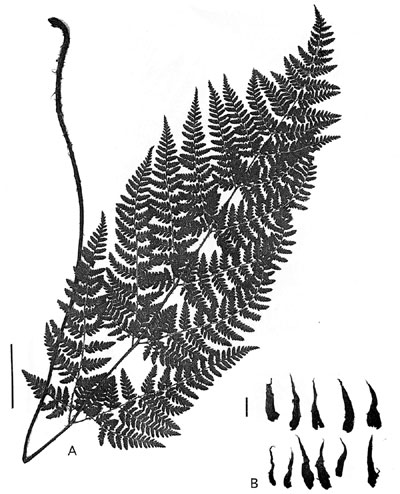| Dryopteris aemula | ||
Hay-scented wood fern | ||
|
Etymology
Latin: aemula, rivaling or imitating
Description
Rhizome: erect.
Frond: 75 cm high by 15 cm wide, deciduous in colder areas, monomorphic, blade/stipe ratio: 1:1 to 2:1. Stipe: grooved, dark purple-brown at base, shading to green near blade, scales scattered, narrowly lanceolate, pale brown, vascular bundles: 3-7 in a c-shaped pattern. Blade: 3-pinnate-pinnatifid at base, triangular-ovate, the tips arching, sometimes with upturned tips, herbaceous to somewhat leathery, minute sessile, colorless glands, visible on the lower surface. Pinnae: 10 to 20 pair, opposite, basal pair anadromous; costae grooved above, continuous from rachis to costae; segments those on the lowermost pinnae nearly pinnate; margins serrate, spiny, strongly upturned; veins free, forked. Sori: round, in 1 row between midrib and margin, indusium: reniform, at a sinus, sporangia: brownish, maturity: late summer to early fall. Dimensionality: drooping frond tips. Culture
Habitat: moist, acidic, shady woods, banks.
Distribution: Atlantic Europe, Ireland to the Canaries, also the Caucasus, asiatic Turkey.
Hardy to -20�C, USDA Zone 6.
Distinctive Characteristics
the habit with the arching fronds and upturned margins is highly distinctive; the glands on the lower surface separate it from other highly divided species of Dryopteris.
Synonyms
Aspidium aemulum (Aiton) Swartz Allantodia aemula Desv. Lastrea aemula Brackenr. Lastrea foenisecii Watson Nephrodium aemulum Bak. Polypodium aemulum Aiton Polystichum aemulum Presl |
|
|
Notes
Compare to D. aemula and D. dilatata are sometimes confused, particularly with younger plants. However, mature plants of the former are 3-pinnate-pinnatifid at the base vs. just 3-pinnate for the latter. The former has segments with upturned margins; the latter has downturned margins.
Compare to D. aemula and D. dilatata are sometimes confused, particularly with younger plants. However, mature plants of the former are 3-pinnate-pinnatifid at the base vs. just 3-pinnate for the latter. The former has segments with upturned margins; the latter has downturned margins.

Dryopteris aemula. Frond, scale, and indusium. �Drawing by J.E.S. Fecit |
